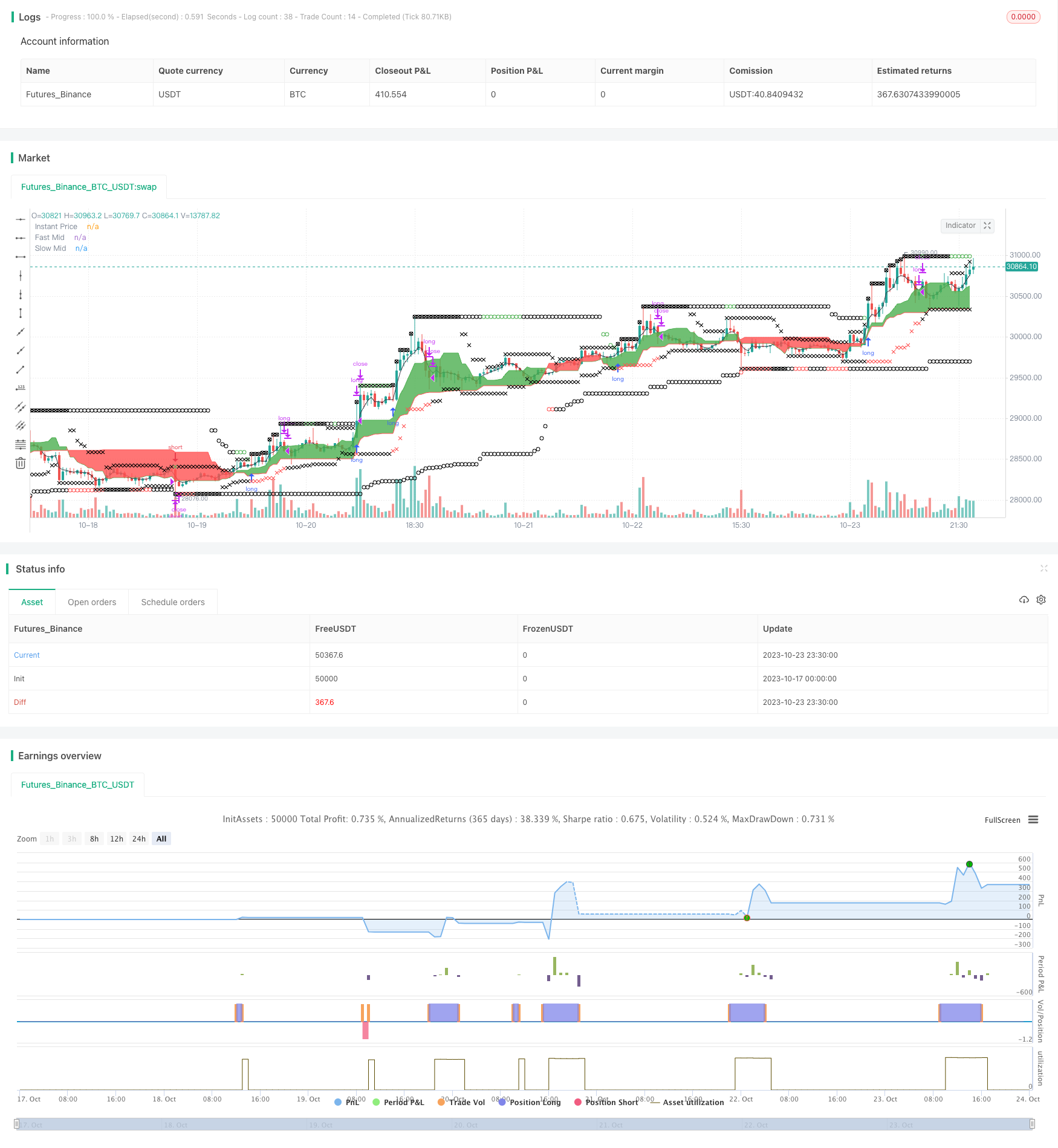
概述
黄金快速突破策略是一个利用快线和慢线进行突破交易的策略。它设置快速窗口和慢速窗口来判断趋势方向,并在突破点进行入场。同时它也设置了止损平仓点来控制风险。该策略适用于高波动的品种,可以捕捉趋势的快速变化来获利。
策略原理
该策略同时设置了一个快速窗口和一个慢速窗口。快速窗口默认是13周期,用于捕捉短期趋势;慢速窗口默认是52周期,用于判断中长期趋势方向。策略计算快速窗口和慢速窗口的中线,并绘制在图表上。当快速中线上穿慢速中线时,表示短期趋势变化,有可能形成新的上涨趋势;当快速中线下穿慢速中线时,表示短期趋势转向,有可能形成新的下跌趋势。
在快速中线上穿慢速中线时,如果即时价格也高于快速中线,则形成买入信号,以慢速窗口最高价作为买入停损单,进行做多开仓。在快速中线下穿慢速中线时,如果即时价格也低于快速中线,则形成卖出信号,以慢速窗口最低价作为卖出停损单,进行做空开仓。
此外,策略也设置了止损平仓点。做多止损平仓点为快速窗口最低价和慢速窗口最低价的较大值,做空止损平仓点为快速窗口最高价和慢速窗口最高价的较小值。这可以确保止损点位于当前趋势方向之外,以控制风险。
当不满足做多做空条件时,策略会平仓。这可以避免当趋势盘整时带来不必要的损失。
优势分析
该策略具有以下优势:
快速判断趋势变化,适合高波动品种。通过快速窗口和慢速窗口的结合,可以快速捕捉到短期和中长期趋势的变化,适合如黄金等高波动品种。
风险控制到位。通过合理的止损机制,可以及时止损,有效控制策略风险。
交易逻辑清晰简单。基于快慢均线交叉进行判断,然后设定合理的止损点,非常简单明了。
容易优化和扩展。可以通过调整参数等方式进行优化,也可以加入更多判断指标进行扩展。
风险分析
该策略也存在一些风险:
快速窗口容易被噪音影响。快速窗口作为短期判断指标,可能受到较大的市场噪音影响,导致产生错误信号。
慢速窗口有滞后性。中长期趋势转向时,慢速窗口可能存在一定滞后,导致信号判断滞后。
止损点可能过于接近。止损点直接取快慢窗口数据,可能距离最近价格过近,容易被止损。
无法有效处理盘整市场。当市场持续盘整时,该策略容易产生错误信号导致亏损。
对应解决方法:
调整快速窗口周期,加入其他过滤指标。
优化慢速窗口周期,加入移动平均线等指标辅助判断。
设置止损点与最近价格有一定缓冲区。
增加对盘整的判断指标,避免错信号。
优化方向
该策略可以从以下几个方向进行优化:
优化快速窗口和慢速窗口的周期参数,使之更好适应不同品种。
增加仓位管理机制,通过调整仓位来控制风险。
增加止盈策略,在盈利一定比例后主动止盈。
增加更多指标过滤,形成更稳定的交易信号。比如增强买卖点,避免错误信号。
增加对于特定形态的判断,如三角形收敛、头肩顶背驰等,以提升策略的胜率。
增加机器学习算法,利用大数据训练判断模型,自动优化策略的参数。
总结
黄金快速突破策略是一个基于快慢均线交叉的趋势突破策略。它能够快速捕捉趋势变化,适合如黄金等高波动品种。同时它也设置了合理的止损机制来控制风险。该策略具有交易逻辑简单清晰、易于优化等优点。我们也通过分析找到该策略可能存在的风险,并给出了相应的优化方向。总体来说,该策略为我们提供了一个高效捕捉趋势变化的思路,具有很好的实用价值。通过不断优化和改进,可以将其打造成一个稳定可靠的趋势突破交易系统。
/*backtest
start: 2023-10-17 00:00:00
end: 2023-10-24 00:00:00
period: 30m
basePeriod: 15m
exchanges: [{"eid":"Futures_Binance","currency":"BTC_USDT"}]
*/
//@version=2
strategy("Breakout Scalper", overlay=true)
fast_window = input(title="Fast Window", defval=13, minval=1)
slow_window = input(title="Slow Window", defval=52, minval=1)
instant_period = input(title="Instant Period", defval=3, minval=1)
fast_low = lowest(fast_window)
fast_high = highest(fast_window)
fast_mid = (fast_low + fast_high) / 2
slow_low = lowest(slow_window)
slow_high = highest(slow_window)
slow_mid = (slow_low + slow_high) / 2
instant_price = ema(close, instant_period)
plot(instant_price, title="Instant Price", color=black, transp=50)
fp = plot(fast_mid, title="Fast Mid", color=green)
sp = plot(slow_mid, title="Slow Mid", color=red)
fill(fp, sp, color=(fast_mid > slow_mid ? green : red))
is_buy_mode = (instant_price > fast_mid) and (fast_mid > slow_mid)
is_sell_mode = (instant_price < fast_mid) and (fast_mid < slow_mid)
entry_color = is_buy_mode ? green : (is_sell_mode ? red : na)
exit_color = is_buy_mode ? red : (is_sell_mode ? green : na)
entry_buy_stop = slow_high
entry_sell_stop = slow_low
exit_buy_stop = max(fast_low, slow_low)
exit_sell_stop = min(fast_high, slow_high)
strategy.entry("long", strategy.long, stop=entry_buy_stop, when=is_buy_mode)
strategy.exit("stop", "long", stop=exit_buy_stop)
strategy.entry("short", strategy.short, stop=entry_sell_stop, when=is_sell_mode)
strategy.exit("stop", "short", stop=exit_sell_stop)
strategy.close("long", when=(not is_buy_mode))
strategy.close("short", when=(not is_sell_mode))
entry_buy_stop_color = (strategy.position_size == 0) ? (is_buy_mode ? green : na) : na
plotshape(entry_buy_stop, location=location.absolute, color=entry_buy_stop_color, style=shape.circle)
entry_sell_stop_color = (strategy.position_size == 0) ? (is_sell_mode ? red : na) : na
plotshape(entry_sell_stop, location=location.absolute, color=entry_sell_stop_color, style=shape.circle)
exit_buy_stop_color = (strategy.position_size > 0) ? red : na
plotshape(exit_buy_stop, location=location.absolute, color=exit_buy_stop_color, style=shape.xcross)
exit_sell_stop_color = (strategy.position_size < 0) ? green : na
plotshape(exit_sell_stop, location=location.absolute, color=exit_sell_stop_color, style=shape.xcross)